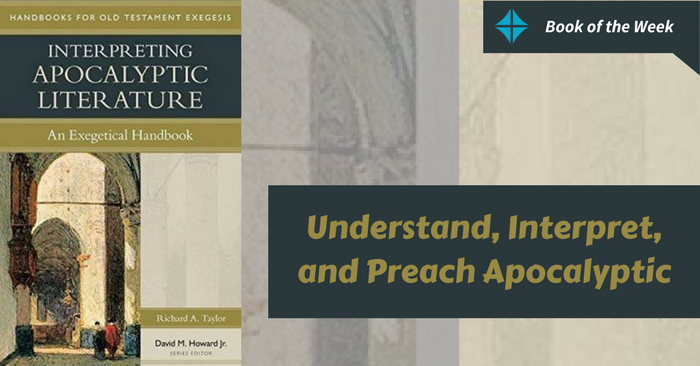
Understanding, interpreting, and preaching apocalyptic are not at the top of many peoples’ priority lists. In fact, even defining the term “apocalyptic” has been an academic problem for decades. Is it a genre, a worldview, a type of prophecy, or purely fiction?
Years ago, I read Interpreting the Book of Revelation by J. Ramsay Michaels. It’s a helpful book; suddenly, with a brief chapter on apocalyptic literature, I was able to see that Revelation wasn’t this mysterious book with no ability to unlock its interpretive key. In reality, it fit into a broad category of apocalyptic, and suddenly the book became approachable for me. Don’t underestimate the power of a well-written introductory book to open up parts of Scripture to you that you formerly thought inaccessible.
Kregel Academic has now put out a new introduction to apocalyptic literature in their Handbooks for Old Testament Exegesis series. Richard Taylor’s Interpreting Apocalyptic Literature is a commendable introduction that I wish would have been placed in my hands when I entered seminary. He helps define apocalyptic, teaches how to interpret texts such as Daniel, apocalyptic sections of the prophets, and extrabiblical apocalyptic texts, and also has a chapter on preaching apocalyptic. (Perhaps the best part about it is that it is priced very affordably.)
Here are some of the useful takeaways from the book:
- When defining apocalyptic, we must consider apocalypses, apocalypticism, apocalyptic literature, apocalyptic eschatology, apocalyptic discourse, and proto-apocalyptic texts. The academic discussion of the definition of “apocalyptic” must consider all these terms as distinct yet connected, and Taylor defines them very helpfully (pp. 31-36).
- Apocalyptic texts are found in Daniel, Isaiah 24-27, Ezekiel 1-2, 38-39; Zechariah 9-14; Joel 2; Malachi 4 (although he calls all these “incipient apocalyptic”); 1 Enoch; 2 Enoch; Jubilees 23; 4 Ezra (2 Esdras 3-14); 2 Baruch; Apocalypse of Abraham 9-32; Testament of Levi 2-5; Testament of Abraham 2; Apocalypse of Zephaniah 3-7; Testament of Moses; Community Rule (1QS 3-4); War Scroll; New Jerusalem (5Q15) (pp. 42-65).
- Major themes of apocalyptic literature include developed angelology, ethical dualism, deterministic outlook, imminent crisis, faithful remnant, divine judgment, and eschatological hope (pp. 73-85).
- Characteristic features of apocalyptic literature include literary expression (i.e., it is a form of writing), revelatory content, dreams and visions, pseudonymous authorship, hiddenness and secrecy, and pervasive symbolism (pp. 65-73).
- Figurative language used throughout apocalyptic literature includes simile, metaphor, metonymy, hypocatastasis, and synecdoche (pp. 88-96).
- Taylor provides useful annotated bibliographies for textual-critical resources, original languages, lexical resources, grammatical resources, primary sources for apocalyptic texts, general works on apocalyptic literature, essays from syposia on apocalypticism, apocalyptic literature and the Dead Sea Scrolls, Preaching Apocalyptic Literature, and pseudepigraphal literature.
- Taylor then spends a couple chapters using Daniel and Joel as illustrations for how to interpret apocalyptic texts and how to bridge them for contemporary application in sermons.
This book is concise and packed with useful information. My one criticism would be that his section on interpreting apocalyptic includes too much information on exegesis in general rather than sticking with information that is specific to apocalyptic. If the reader finds this section too basic, he or she can skip on to the next sections.
I’d recommend this work as one of the best concise introductions to apocalyptic on the market. Taylor has provided students and pastors with a useful tool to help them get a grasp on apocalyptic literature, which will enable them to approach apocalyptic portions of the Bible with much more confidence… and perhaps even to preach those texts!
Preview or buy it here on Amazon.

